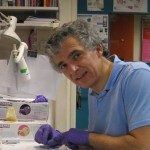Link to Pubmed [PMID] – 11901150
J. Biol. Chem. 2002 May;277(21):18875-80
Three-dimensional models of thrombin complexed with large fragments of the fibrinogen Aalpha and Bbeta chains are presented. The models are consistent with the results of recent mutagenesis studies of thrombin and with the information available on naturally occurring fibrinogen mutants. Thrombin recognizes fibrinogen with an extended binding surface, key elements of which are Tyr(76) in exosite I, located about 20 A away from the active site, and the aryl binding site located in close proximity to the catalytic triad. A highly conserved aromatic-Pro-aromatic triplet motif is identified in the primed site region of fibrinogen and other natural substrates of thrombin. The role of this triplet, based on the three-dimensional models, is to correctly orient the substrate for optimal bridge binding to exosite I and the active site. The three-dimensional models suggest a possible pattern of recognition by thrombin that applies generally to other natural substrates.

